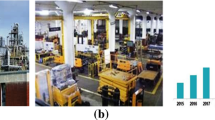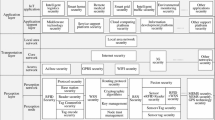Abstract
As information technology continuously progresses, more applied technologies are developed, such as radio frequency identification (RFID). In this paper, we propose a novel digital television (DTV) structure that uses RFID for encryption. RFID is widely used for various applications because of its advantages such as an extended lifetime and security, and it is less affected by environmental constraints. The proposed protocol uses RFID for encryption to withstand many attacks that the traditional system is vulnerable to, such as impersonation attack, replay attack and smart card cloning. Compared with other protocols, the proposed protocol is more secure and efficient. Thus, our proposed protocol makes the DTV framework more complete and secure.




Similar content being viewed by others
References
Chen, Y. Y., Tsai, M. L., & Jan, J. K. (2011). The design of RFID access control protocol using the strategy of indefinite-index and challenge-response. Computer Communications, 34(3), 250–256.
Chien, H. Y. (2006). Secure access control schemes for RFID systems with anonymity. In Proceedings of the 7th international conference on mobile data management.
Chien, H. Y. (2007). SASI: a new ultralightweight RFID authentication protocol providing strong authentication and strong integrity. IEEE Transactions on Dependable and Secure Computing, 4(3), 337–340.
Chien, H. Y., & Chen, C. H. (2007). Mutual-authentication protocol for RFID conforming to EPC class 1 generation 2 standards. Computer Standards & Interfaces, 29(2), 254–259.
Chung, M. G., & Kim, Y. (2008). An integrated scheme for authentication and access control in a digital TV environment. In Proceedings of IEEE international conference on consumer electronics (pp. 1–2).
Cruselles, E., Melus, J. L., & Soriano, M. (1993). An overview of security in eurocrypt conditional access system. In Proceedings of IEEE global telecommunications conference (pp. 188–193).
Diffie, W., & Hellman, M. E. (1976). New directions in cryptography. IEEE Transactions on Information Theory, 22(6), 644–654.
Dimitriou, T. (2005). A lightweight RFID protocol to protect against traceability and cloning attacks. In Proceedings of the first international conference on security and privacy for emerging areas in communications networks (pp. 59–66).
Garcia, M., Canovas, A., Edo, M., & Lloret, J. (2009). A QoE management system for ubiquitous IPTV devices. In Proceedings of IEEE international conference on mobile ubiquitous computing (pp. 147–152).
Hou, T. W., Lai, J. T., & Yeh, C. L. (2007). Based on cryptosystem secure communication between set-top box and smart card in DTV broadcasting. In Proceedings of IEEE intelligent information communication technologies for better human life (pp. 82–85).
Hwang, M. S., Lee, C. C., Lee, J. Z., & Yang, C. C. (2005). A secure protocol for bluetooth piconets using elliptic curve cryptography. Telecommunication Systems, 29(3), 165–180.
IEEE Standards. (2004). IEEE 802.11i-2004: Amendment 6: medium access control (MAC) security enhancements. 2004-07-23, Retrieved 2007-12-21.
Jiang, T., Zheng, S., & Liu, B. (2004). Key distribution based on hierarchical access control for conditional access system in DTV broadcast. IEEE Transactions on Consumer Electronics, 50(1), 225–230.
Jiang, T., Hou, Y., & Zheng, S. (2004). Secure communication between set-top box and smart card in DTV broadcasting. IEEE Transactions on Consumer Electronics, 50(3), 882–886.
Jun, E., Rhee, H. S., Jung, S. W., & Lee, D. H. (2010). A fingerprint-based user authentication scheme using smart cards in IPTV environments. In Proceedings of IEEE international conference on information science (pp. 1–8).
Kanjanarin, W., & Amornraksa, T. (2001). Scrambling and key distribution scheme for digital television. In Proceedings of IEEE international conference on networks (pp. 140–145).
Kim, T., & Bahn, H. (2008). Implementation of the storage manager for an IPTV set-top box. IEEE Transactions on Consumer Electronics, 54(4), 1770–1775.
Lee, S. M., Hwang, Y. J., Lee, D. H., & Lim, J. I. (2005). Efficient authentication for low-cost RFID systems. In Proceedings of international conference on computational science and its applications (pp. 619–627).
Lee, J. S., Rhee, H. S., & Lee, D. H. (2008). Efficient and secure communication between set-top box and smart card in IPTV broadcasting. In Proceedings of IEEE international conference on convergence and hybrid information technology (pp. 307–310).
Lee, C. C., Li, C. T., Chen, T. Y., Wu, P. H., & Chen, C. T. (2011). A new key exchange protocol with anonymity between STB and smart card in IPTV broadcasting. In Proceedings of IEEE international conference on wireless communications, networking and mobile computing (pp. 23–25).
Lee, C. C., Liao, I. E., & Hwang, M. S. (2011). An efficient authentication protocol for mobile communications. Telecommunication Systems, 46(1), 31–41.
Lehtonen, M., Ostojic, D., Ilic, A., & Michahelles, F. (2009). Securing RFID systems by detecting tag cloning. In Proceedings of the 7th international conference on pervasive computing (pp. 291–308).
Macq, B., & Quisquater, J. (1995). Cryptology for digital TV broadcasting. Proceedings of the IEEE, 83(6), 944–957.
Moon, J., Kim, J., Park, J., & Paik, E. (2008). Achieving interoperability in conditional access systems through the dynamic download and execution of cryptographic software for the IPTV system. In Proceedings of IEEE international conference on convergence and hybrid information technology (pp. 380–385).
Moon, J., Kim, J., Park, J., Paik, E., & Park, K. (2009). A dynamic conditional access system for IPTV multimedia systems. In Proceedings of IEEE international conference on systems and networks communications (pp. 224–229).
Prasertsatid, N. (2004). Implementation conditional access system for pay-TV based on Java card. In Proceedings of IEEE conference on computational electromagnetic and its application.
Rieback, M. R., Crispo, B., & Tanenbaum, A. S. (2006). The evolution of RFID security. In Proceedings of IEEE pervasive computing (pp. 62–69).
Roberts, C. M. (2006). Radio frequency identification (RFID). Computers & Security, 25(1), 18–26.
Rotter, P. (2008). A framework for assessing RFID system security and privacy risks. IEEE Pervasive Computing, 7(2), 70–77.
Shihab, E., Wan, F., Cai, L., Gulliver, A., & Tin, N. (2007). Performance analysis of IPTV traffic in home networks. In Proceedings of IEEE global telecommunications conference (pp. 5341–5345).
Shim, K. (2003). Cryptanalysis of mutual authentication and key exchange for low power wireless communication. IEEE Communications Letters, 7(5), 248–250.
Shirazi, H., Cosmas, J., & Cutts, D. (2010). A cooperative cellular and broadcast conditional access system for Pay-TV systems. IEEE Transactions on Broadcasting, 56(1), 44–57.
Smart Card Alliance (2012). RFID tags and contactless smart card technology: comparing and contrasting applications and capabilities. Available in http://www.hidglobal.com/documents/tagsVsSmartcards_wp_en.pdf.
Wey, J. S., Luken, J., & Heiles, J. (2009). Standardization activities for IPTV set-top box remote management. IEEE Internet Computing, 13(3), 32–39.
Wong, D. S., & Chan, A. H. (2001). Mutually authentication and key exchange for low power wireless communications. In Proceedings of IEEE military communications conference (pp. 39–43).
Xenakis, C., & Ntantogian, C. (2007). Security architectures for B3G mobile networks. Telecommunication Systems, 35(3), 123–139.
Yan, X., & Liu, X. (2011). Evaluating the energy consumption of the RFID tag collision resolution protocols. Telecommunication Systems. doi:10.1007/s11235-011-9563-8.
Yoon, E. J., & Yoo, K. Y. (2006). A new secure key exchange protocol between STB and smart card in DTV broadcasting. In Proceedings of WISI (pp. 165–166).
Yoon, E. J., & Yoo, K. Y. (2009). Robust key exchange protocol between set-top box and smart card in DTV broadcasting. Informatica, 20(1), 39–150.
Yoon, E. J., & Yoo, K. Y. (2011). ECC-based key exchange protocol for IPTV service. In Proceedings of IEEE international conference on information science (pp. 547–552).
Yu, F., & Krishnamurthy, V. (2005). Efficient radio resource management in integrated WLAN/CDMA mobile networks. Telecommunication Systems, 30(1), 177–192.
Zhang, D., Zhou, J., Guo, M., & Cao, J. (2011). TASA: tag-free activity sensing using RFID tag arrays. IEEE Transactions on Parallel and Distributed Systems, 22, 558–570.
Acknowledgements
This research was partially supported by the National Science Council, Taiwan, R.O.C., under contract no.: NSC 101-2221-E-030-018 and NSC 101-2221-E-165-002.
Author information
Authors and Affiliations
Corresponding author
Rights and permissions
About this article
Cite this article
Lee, CC., Chen, CT., Li, CT. et al. A practical RFID authentication mechanism for digital television. Telecommun Syst 57, 239–246 (2014). https://doi.org/10.1007/s11235-013-9844-5
Published:
Issue Date:
DOI: https://doi.org/10.1007/s11235-013-9844-5




